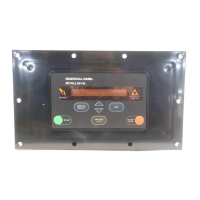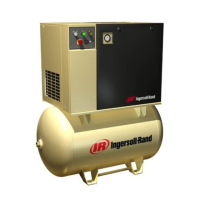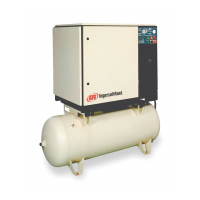*4. If the unit was modulating and the lower limit switch gave a false
indication of being closed, possibly due to a faulty connection.
*5. False reading on the inlet vacuum transducer due to mis-calibration or
disconnected tubing.
*Most likely causes of alarm
Use the following procedure to investigate and correct if the alarm occurs.
1. Check the connections on the starter interface board for the stepper limit
switch. Look for frayed connections.
Check calibration of vacuum transducer. Activate inlet vacuum with unit
off and read value; it should be 0. If any other value is shown, recalibrate
the transducer.
Check the tubing connections to the transducer.
2. Remove the inlet filter, but leave the bracket in place. Observe the inlet
vacuum in the display.
3. Load the unit - valve should be fully open.
4. Unload unit and read the vacuum.
Vacuum should be in the high range of 10-13 psi.
5. If inlet vacuum is 3 psi or less and alarm occurs with power on the unit,
go to the analog board and measure DC voltage as follows:
Terminal 4 wire Blk +5 Volt DC This is power to the transducer.
3 wire Red
Terminal 1 wire Gr. + or - 2.5 millivolt
2 wire Wh. (Typically this will be one millivolt or less)
These measurements determine if the transducer is normal.
6. The analog board would be suspect only if all sensors were showing
alarms because the signal is interpreted on one circuit into the controller.
LOW UNLOADED SUMP PRESSURE - ALARM
The display will read “Low Unloaded Sump Pressure” when the sump pressure
of the compressor is below 15 PSI.
NOTE: This signal (alarm) is ignored after the start button is engaged.
(The period the signal is ignored is actually 10 seconds after
Star-Delta transition to “run”, or 10 seconds after full voltage
starter contactor engagement. After these 10 seconds pass, the
alarm becomes active.)
The alarm shutdown point is 15 PSI. Sump pressure must be 15 PSI or greater
to allow the compressor to run. If sump pressure has been greater than 15 PSI
and is decreasing, the alarm will occur should sump pressure fall below 15 PSI
for 15 seconds. Normal range of sump pressure is 24 to 33 PSI.
NORMAL OPERATION
When the compressor is started normally, sump pressure must make 15 PSI
within 10 seconds after Star-Delta transition to “run”, or 10 seconds after full
voltage starter contactor engagement. If 15 PSI is not seen, compressor will
shutdown, displaying “LOW UNLOADED SUMP PRESSURE”.
When the compressor is operating normally on a system, loading and unloading
routinely, if sump pressure drops to 15 PSI or lower for more than 15 seconds
for any reason, the compressor will shutdown displaying “LOW UNLOADED
SUMP PRESSURE”.
TROUBLESHOOTING SEQUENCE
The most likely cause of LOW UNLOADED SUMP PRESSURE is misposition-
ing of the inlet butterfly valve.
1. Check all mechanical areas of the butterfly valve. Loose rivets, broken,
misaligned, or loose coupling, stepper motor failure or sticking valve, are
likely causing factors.
2. Check sump pressure transducer 3 APT for leaks or leaks associated
within the tubing carrying the pressure signal.
3. Check that minimum pressure valve is stuck completely open if the unit
is discharging into an open system.
4. If mechanical areas of the valve seem normal, refer to “HIGH INLET
VACUUM - ALARM”, TROUBLESHOOTING SEQUENCE. Follow
through this sequence, and resume normal operation.
-47- -48-

